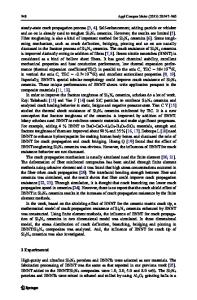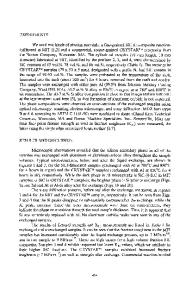Processing and mechanical behavior of SiC fiber-reinforced Si 3 N 4 composites
- PDF / 17,929,258 Bytes
- 11 Pages / 576 x 792 pts Page_size
- 82 Downloads / 395 Views
J-F. LeCoustaouec Textron Specialty Materials, Lowell, Massachusetts 02851 (Received 26 November 1990; accepted 14 May 1991)
The interfacial properties and mechanical behavior of the SCS-6/Si 3 N 4 composites fabricated by hot pressing from powder lay-up and tape lay-up techniques were studied. Interfacial shear strength and frictional stress were measured using an indentation test. Fracture toughness and work-of-fracture were measured using a three-point bending test on a chevron-notched specimen. The influence of interfacial shear strength on the toughening mechanisms and crack propagation behavior were investigated. The results indicate that the processing routes and fiber orientation will affect the interfacial properties, which in turn have a significant influence on mechanical properties.
I. INTRODUCTION Silicon nitride (Si 3 N 4 ) based ceramics possess excellent high temperature strength, oxidation resistance, good thermal shock resistance, low density, and low coefficient of thermal expansion. These properties make them ideal candidates for high temperature applications such as aerospace structures and turbine engines. However, their brittle nature and flaw sensitivity remain a major concern for a variety of potential applications. One of the most effective methods for improving their properties and reliability is by reinforcing them with continuous ceramic fibers. Recent studies have shown that the addition of SiC fiber into Si 3 N 4 through hot pressing or reaction bonding can yield a material that is stronger and tougher than the monolithic S ^ ^ . 1 " 5 The improvement in strength and toughness is achieved through several micromechanisms, including fiber/matrix debonding, bridging, and fiber pullout.6 However, processing difficulties including the nonuniform distribution of the fibers, degradation of the fibers at high processing temperatures, and incomplete densification of the matrix have limited the improvement of its mechanical properties. Another area of great concern is the interfacial properties between the fiber and matrix. The strength of the fiber/matrix bonding plays a critical role on the ability of the fiber to bridge cracks or deflect cracks along the interface. In general, a weakly bonded interface leads to a toughened composite, whereas a strongly bonded interface results in brittle behavior. A significant effort is still needed to develop new or improved processing techniques and to understand better the processing-interfaces-performance relationship so as to develop a satisfactory Si 3 N 4 matrix composite. The purpose of this work is to characterize the effects of processing routes and fiber orientation on 1926 http://journals.cambridge.org
J. Mater. Res., Vol. 6, No. 9, Sep 1991
Downloaded: 13 Mar 2015
the mechanical properties of the SCS-6 fiber-reinforced Si 3 N 4 matrix composites at room temperature. The SCS6/Si 3 N 4 composites were fabricated using powder lay-up and tape lay-up techniques. The microstructure, interfacial properties, and fracture toughness of the resulting
Data Loading...











